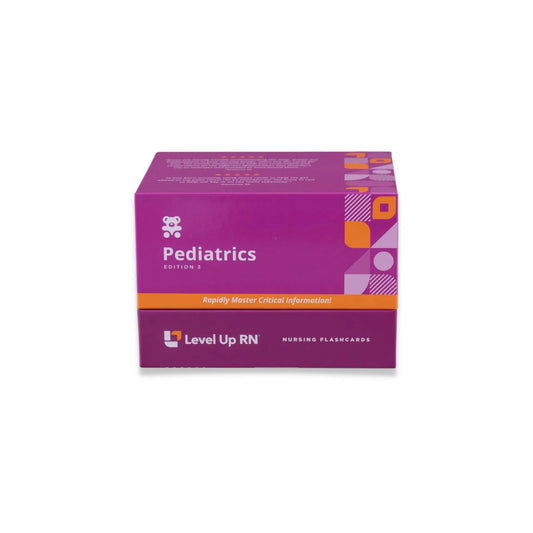Peds, part 20: Respiratory Disorders - Apnea of Prematurity, Bronchopulmonary Dysplasia, Respiratory Distress Syndrome
Updated: Cathy ParkesThe following disorders: Apnea of Prematurity, Bronchopulmonary Dysplasia (BPD), and Respiratory Distress Syndrome (RDS). The pathophysiology, risk factors, signs/symptoms, treatment, and nursing care associated with these disorders.
Full Transcript: Peds, part 20: Respiratory Disorders - Apnea of Prematurity, Bronchopulmonary Dysplasia, Respiratory Distress Syndrome
Full Transcript: Peds, part 20: Respiratory Disorders - Apnea of Prematurity, Bronchopulmonary Dysplasia, Respiratory Distress Syndrome
Hi, I'm Cathy with Level Up RN. In this video, I will be talking about pediatric respiratory disorders that affect premature infants. This includes apnea of prematurity, bronchopulmonary dysplasia, and respiratory distress syndrome. If you have our Level Up RN pediatric nursing flashcards, definitely pull those out so you can follow along with me. At the end of the video, I'm going to give you guys a little quiz to test your knowledge of some of the key points I'll be making in this video. So definitely stay tuned for that.
First let's talk about apnea of prematurity, which is where we have a pause in breathing in a premature infant. So infants born prior to 37 weeks of gestation are going to be at higher risk for this disorder, and it's caused by immature respiratory control centers in the medulla. So with apnea of prematurity, the pause in breathing will last for more than 20 seconds. Or we may have a shorter period of apnea that occurs with bradycardia and/or oxygen desaturation. Treatment for this condition includes theophylline, caffeine, as well as a CPAP. In terms of nursing care, we want to stimulate the baby during periods of apnea, and we want to perform a car seat challenge prior to discharging the baby. So we want to place the baby in a car seat and observe the baby for apnea, bradycardia, as well as oxygen desaturation for a prolonged amount of time before we would safely discharge that infant.
Next, let's talk about bronchopulmonary dysplasia which is a breathing disorder that is primarily found in premature infants, and it causes the abnormal development of lung tissue. And it has a pretty high rate of morbidity and mortality. So risk factors associated with this condition include prematurity, low birth weight infants, as well as mechanical ventilation and high levels of oxygen. So these high levels of oxygen and mechanical ventilation can injure the lungs and cause this bronchopulmonary dysplasia. Signs and symptoms will include respiratory distress, so grunting, nasal flaring, subcostal retractions, tachypnea, as well as cyanosis. This disorder can also cause difficulty with feeding as well as apnea.
In terms of treatment, we can provide the infant with a CPAP and oxygen. We want to avoid mechanical ventilation if possible, but if necessary, it can be used. Medications can include diuretics to help get rid of excess fluid because pulmonary edema is often an issue with this disorder. In addition, bronchodilators can be used as well as corticosteroids. And then in terms of nursing care, we're going to want to provide small, frequent feedings for the baby because, again, they're going to have feeding difficulty and difficulty with breathing. So we're going to have to do that in kind of small segments instead of a long feeding session. And we're also going to want to increase the baby's calorie and protein intake using human milk fortifiers.
Finally, let's talk about respiratory distress syndrome which is a breathing disorder caused by immature lungs due to lack of surfactant. Without enough surfactant, the alveoli cannot inflate fully, and this leads to impaired ventilation. Risk factors include prematurity as well as maternal infection or diabetes. Signs and symptoms include respiratory distress symptoms such as tachypnea, grunting, nasal flaring, subcostal retractions, as well as cyanosis. This condition can also cause difficulty with feeding. If mom gets an amniocentesis prior to giving birth, and we find that the LS ratio in the amniotic fluid is under two to one, then that is indicative of immature lungs. And if the baby is born prematurely, then they will be at higher risk for respiratory distress syndrome. Treatment will include surfactants, so that is the underlying cause of this disorder. So we will be giving the baby artificial surfactant. In addition, the infant may require oxygen therapy, a CPAP, and, if necessary, mechanical ventilation. In terms of nursing care, we're going to want to assess the baby for respiratory distress. We're going to suction when necessary, collaborate with respiratory therapy, and frequently assess the baby's vital signs.
All right, it's quiz time. Are you guys ready? I have three questions for you. First question. Apnea of prematurity is defined as a pause in breathing greater than blank seconds. The answer is 20. Question number two, what breathing disorder in a premature infant is caused by a lack of surfactant? The answer is respiratory distress syndrome. Question number three, what is the significance of a LS ratio under two to one in the amniotic fluid? The answer is, this means that the baby's lungs are immature, which places them at higher risk for respiratory distress syndrome. All right. That's it for this video. If you've found it helpful, be sure to like this video and leave me a comment. Take care and good luck with studying.
And it could be caused by prenatal causes, such as maternal infection or postnasal-- nasal causes. Good grief. So infants born prior to 37 weeks of gestation are at higher risk for the doo doo doo doo doo doo doo doo doo. Okay, sorry, try again. First let's talk about apnea of prematurity which is where we have a pause in breathing in a premature infant. So infants born prior to 37 weeks of gestation are at higher risk for this disorder. And this is caused to to.


